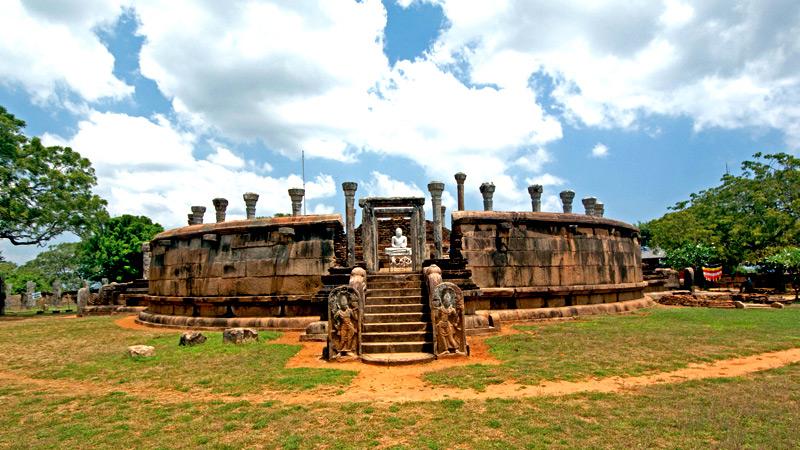From Trincomalee to Tiriyai Vatadage-BY MAHIL WIJESINGHE

Vatadage at Tiriyai
Source:Sundayobserver
The B424 secondary road is the main road linking the districts of Trincomalee and Vavuniya in the Eastern and the Northern Provinces of Sri Lanka. As we drove down this rarely used road, we discovered the many engaging sights leading up to Tiriyai.
 North of Trincomalee, a 43 kilometre strand of beach runs uninterrupted up along the coast past Kuchchaveli. One of Sri Lanka’s premier beach resorts, Nilaveli, is the centre of this strip, geographically as well as in terms of tourist interest.
North of Trincomalee, a 43 kilometre strand of beach runs uninterrupted up along the coast past Kuchchaveli. One of Sri Lanka’s premier beach resorts, Nilaveli, is the centre of this strip, geographically as well as in terms of tourist interest.
Most of the beach hotels and guest houses are between Uppaveli and Nilaveli. The major recreation is sun-bathing and deep-sea fishing. Sea bathing is a popular past-time among the foreigners and locals who flock to the crystal clear Nilaveli beach. The Navy has deployed life-saving guards to protect the sea bathers. The local vendors sell foods and swimming cloths alongside the beach.
Hotels along this strip tout ‘Pigeon Island’, just a few hundred metres offshore from most of the Nilaveli hotels, as an ideal location for half-day snorkeling excursions. It is only about a 15-minute trip by outbound motorboat. But visitors often find this tiny accumulation of sand, shells and rocks to be highly overrated. Pigeon Island takes its name from its importance as a breeding ground for the blue rock pigeon.
Shell-collecting spot
Back on the mainland, Red Rocks Bay is an excellent swimming and even better a shell-collecting spot. Kuchchaveli, another ten kilometres north, is a fine swimming and fishing area. Along the road, vendors sell fresh dried fish in makeshift huts to travellers at reasonable prices. Before the bridge was constructed, travellers had to cross the Kunchikumban Aru lagoon mouth by vehicular ferry.
We drove through an almost deserted landscape except for an occasional vehicle that whizzed past us. We often caught glimpses of herds of cattle and goats crossing the road and grazing on the dried paddy fields.
The semi-arid scenery of brownish red soil peppered with greenery was calm and quiet. The sudden gush of wind blowing from the Kuchchaveli salterns softened the harshness of the late morning sun.

The saltern spread for acres and acres and was encircled by a barbed wire fence.
We sighted the recently harvested salt mounds covered with cadjans leaves. As we passed, a herd of goats scattered, while their shepherd looked on.
It was extremely hot by now, and we were seeking some shade. We stopped the vehicle under a shady tree beside the road and walked under the trees in to the village.
It seemed as if everyone was indoors during this hot sunny noon. A herd of cattle was comfortably settled on the dusty ground and were not at all bothered by our presence.
The sun was blazing as it was close to noon when we drove along the Trincomalee-Pulmoddai road, passing towns such as Nilaveli, Irrakkandi, Kumpurupiddi and Kuchchaveli. Finally, we arrived at the quaint village of Tiriyai.
We were hot and thirsty and decided to refresh ourselves with a cool drink at the little shop in the village. Most villagers in Tiriyai are returners to their ancestral lands after the battle against terrorism ended. From the Kuchchaveli main road, we turned left and drove down another 12 kms inland to reach our destination –Tiriyaivatadage.
We drove along a deserted road under a thick shady forest canopy. The shade abruptly disappeared allowing us a glimpse of a vast stretch of arid paddy fields and in some places lush green paddy fields intermingling with tanks covered with weeds and bird life despite the dryness.
Eventually, we entered the gravel road that led to the Tiriyai Vatadage and reached the much anticipated sacred site. Parking the vehicle under a shady Bo tree, we rested a while and started the uphill climb of the small hillock where the magnificent Vatadage is located.
Modern village
The most important ancient site in the region is the ‘Vatadage’ at Tiriyai, a modern village just inland. This circular pillared temple crowns a prominent rock with a view of the sea. An inscription dates it to the 7th or 8th Century, records its name as Girihandika Cetiya, and claims to enshrine hair relics of the Buddha.
The sacred place of worship is surrounded by panoramic views of the picturesque area.
A peaceful and spiritual environment unfolds itself as you finally see the ‘Vatadage’ and the remains of the BuduGey (image house) and its stone pillars, the fallen statue of the Buddha and bricks.
The top of the Vatadage affords a bird’s eye view of the surrounding area dotted with tanks, a breathtaking sight. Before concluding our journey, we took a moment to enjoy the solitude of the sacred site, drifting back to the days of yore. Devotees from all communities had worshipped at Vatadage at Tiriyai as faith knows no boundaries.







